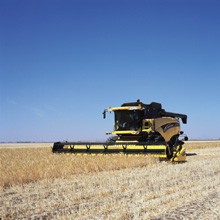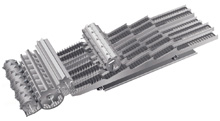
Features
Business & Policy
Consumer Issues
How are fertilizer prices determined?
Global market leaves Canadian farmers bidding for product.
September 26, 2008 By Bruce Barker
 |
| Rick Taillieu, Reduced Tillage LINKAGES |
Global market leaves Canadian farmers bidding for product.
Global. Volatile. Cyclical. Growth. Government. Comp-etitive. Commodity-based. That is how Dean Andersen with Westco Fertilizers in Calgary, Alta., describes the fertilizer market that Canadian manufacturers, wholesalers, retailers and farmers compete in. Even though the prairie fertilizer industry is land-locked, global supply and demand affect local prices. “Fertilizer is commodity in every sense of the word,” explains Andersen.
Wholesale Canadian pricing is based on the age-old market fundamental of the Best Alternative To a Negotiated Agreement (BATNA). Essentially, if there is more than one fertilizer supplier in the market, a buyer looks at his options for every deal. If one seller is asking $1000 per tonne, and the BATNA is $925 per tonne, the buyer and seller will eventually agree on $925 per tonne. Conversely, if the product is in limited demand, the seller will move his product to the highest bidder.
“You always have to know what plan B is. BATNA gives you the framework to establish market prices,” explains Andersen.
Nitrogen capacity moving overseasOverall, the urea trade accounts for a very large percentage of world nitrogen use; in fact it is four times larger than the grain trade. Urea is the most widely used fertilizer product in the world, and the Middle East and the Former Soviet Union (FSU) countries are the largest exporters. However, China and India are the largest producers – they just consume much of what they produce.
At one time, North America was more or less self sufficient in nitrogen production; however that is no longer the case. In the US, from 1999 to 2005, 22 anhydrous ammonia plants were shut down, partially due to high natural gas costs and partially due to inefficient plants that were uncompetitive with overseas production. As a result, urea and UAN fertilizer production declined to the point where today, the US is the largest importer of urea in the world, averaging around six million tonnes annually.
Natural gas comprises 80 to 85 percent of the cash costs to produce anhydrous ammonia. Anhydrous ammonia is also the building block for urea and UAN. Since January 2003, the correlation of AECO – the historical name of a virtual trading hub on the NGX system, located in Alberta, and now known as the Nova Inventory Transfer (NIT) system operated by Trans Canada Pipelines – natural gas price to the western Canadian whole price of urea is 0.26, meaning seven percent of the change in the price of urea can be explained by natural gas, with the remaining due to outside forces. Now known as the Nova Inventory Transfer (NIT) system operated by Trans Canada Pipelines – natural gas price to the western Canadian wholesale price of urea is 0.26, meaning that seven percent of the change in the price of urea can be explained by natural gas, with the remaining due to outside forces.
 “Currently, the price of natural gas only determines whether a fertilizer plant will run or not. It now has very little impact on the price of urea in North America,” explains Andersen.
“Currently, the price of natural gas only determines whether a fertilizer plant will run or not. It now has very little impact on the price of urea in North America,” explains Andersen.
Indeed, North American producers use some of the most expensive natural gas in the world. In 2006, using US$ per mmBTU pricing, the cost of natural gas in Canada averaged $5.75, US at $6.75, Latin America at $0.80 to $2.50, North Africa and the Middle East at $0.75, Russia at $1.25, Ukraine at $3.60, and western Europe at $7.60. US producers are paying almost 10 times the price for natural gas as the Middle East producers. No wonder that much of the North American capacity has moved overseas.
Overseas production is not without risk for North American wholesalers, though. After hurricane Katrina, North American natural gas prices rapidly rose in late November and December 2005, causing a number of urea plants to shut down, forcing US wholesalers to place orders for Middle East imports for March delivery. But a January natural gas price free-fall allowed North American manufacturers to fire up their plants, causing a urea glut and corresponding decline in prices. Because the Middle East urea was already on its way, many importers lost money and ended the spring with expensive inventory, a factor that spilled over to the Canadian market, to the benefit of western farmers.
Globally, Andersen says urea demand is expected to grow nine to 10 mmt by 2010. To keep pace with this increase in demand, new production plants need to be built. Sixty-two percent of the new production will come from the Middle East, 25 percent from North Africa, and 13 percent from other areas with low natural gas prices or government incentives.
In Canada, fertilizer is priced using product landed at New Orleans, Louisiana (NOLA). NOLA is the main entry point for fertilizer into North America. NOLA urea can enter Canada directly by rail or via barge to St. Louis and then rail.
Despite the fact that western Canada has four nitrogen plants, the price is still based on BATNA out of NOLA. However, since it does not make sense to import urea back into Canada when the country is a net exporter, prairie pricing tends to average below that of import products.
Andersen explains that western Canadian urea is priced by obtaining NOLA quotes and then adding up the costs to get the product to Canada. That includes shrink, broker profit, rail freight, dollar exchange rate, handling fees at warehouses, freight to retail sheds and margin.
“NOLA pricing is fairly transparent. All it takes to get wholesale pricing is adding all the costs associated with bringing the product to the marketplace. After that, retail dealers add sufficient margin to cover their costs, service, blending, risk, carrying costs and return on investment, while still being competitive in the retail market,” says Andersen.
In western Canada, Andersen says that prairie pricing usually trades $10 to $20 below import economics. Surprising to many, nitrogen pricing is often more expensive in Alberta, cheaper in Saskatchewan and even less in Manitoba. The reason, explains Andersen, is that Manitoba dealers are closer to NOLA, which means their plan B is also more favourable.
Phosphate governed by import economics as well
The majority of the world’s phos-phate rock is located outside North America. Currently, the U.S. is the largest phosphate producer and exporter in the world with China and Brazil the largest importers. However, declining ore and the threat of a new massive production plant in Saudi Arabia are killing North American expansion plans.
In fact, most of the world’s phos-phate rock is located in North Africa, with Morocco holding 53 percent of world supply. Morocco is currently partnering with Saudi Arabia to develop these reserves. China holds 18 per cent, Tunisia five percent, US only four percent, Russian and Jordan three percent each, and South Africa and Australia two percent each.
Western Canada consumes about 900,000 tonnes of Mono Ammonium Phosphate (MAP) (11-52-0) of which about 600,000 is produced in Alberta. That leaves about one-third of the product to be imported, with 70 percent coming via rail from production facilities in North Carolina and Florida, 25 percent via truck from Idaho mines, and five percent through Minneapolis.
Pricing phosphate uses the same BATNA principle as nitrogen, and worldwide supply and demand determine the price. After going through the BATNA pricing mechanisms, based on Florida pricing, Alberta phosphate production pricing either rises up to import pricing, or declines to import prices to remain competitive.
“If the Florida manufacturers don’t like the prices they are getting in North America, then they will export them for a better price, if they can,” explains Andersen. “They don’t have to sell to us.”
Saskatchewan potash controls the market
Canada, Russia and Belarus are the largest potash producing regions, with Asia and North America consuming the most. World potash production capacity is 58 million tonnes, with Canada producing 21 mmt, Russia 9.79 mmt, and Belarus at 8.3 mmt.
Potash is priced FOB Saskatchewan mines. As a result, in North America, every retail will have a different price based on their freight rate. Currently, the world’s under-utilized potash capacity lies in Saskatchewan. The global supply and demand for potash is so tight, that when plant or shipping failures occur elsewhere, prices go up as buyers
come knocking.
Government policies skew market prices
For various reasons, governments around the world take different approaches to food production and security. Indian farmers pay around $120 per tonne for urea, but the government buys it on the world market for $350 to $400 per tonne and subsidizes the difference. China implements a Value Added Tax of 15 to 30 percent on fertilizer exports in an effort to keep the product at home and the prices lower. Various other governments also pursue policies that affect market prices.
Of course, the renewable fuels initiative, especially in the US, has had a huge impact on grain prices and the corresponding demand for increased fertilizer product.
Canadian dollar exchange rates have had a beneficial effect on fertilizer pricing. Since the spring of 2007, the Canadian dollar rose 16.6 cents to the end of November 2007. The effect was significant. For example, in the US phosphate prices escalated $55 US/ton (2000 lbs.), while Canadian prices declined $45 Cdn/tonne.
“If the dollar would have remained flat from March 2007, our urea prices would have been $76 higher for urea and $108 per tonne higher for phosphate,” says Andersen. “You wouldn’t want to calculate the prices if our dollar was 65 cents.”
Exchange rates aside, other than seasonal bumps up and down, Andersen does not see fertilizer prices dropping significantly until 2010 to 2012. “Overall global demand for nutrients is at a record high. As long as the global agriculture market continues to grow strong, expect demand for fertilizer to remain firm, with strong prices,” he says. “Expect fertilizer prices to drop when global commodity prices drop. Right now, I think we are at a new level.”